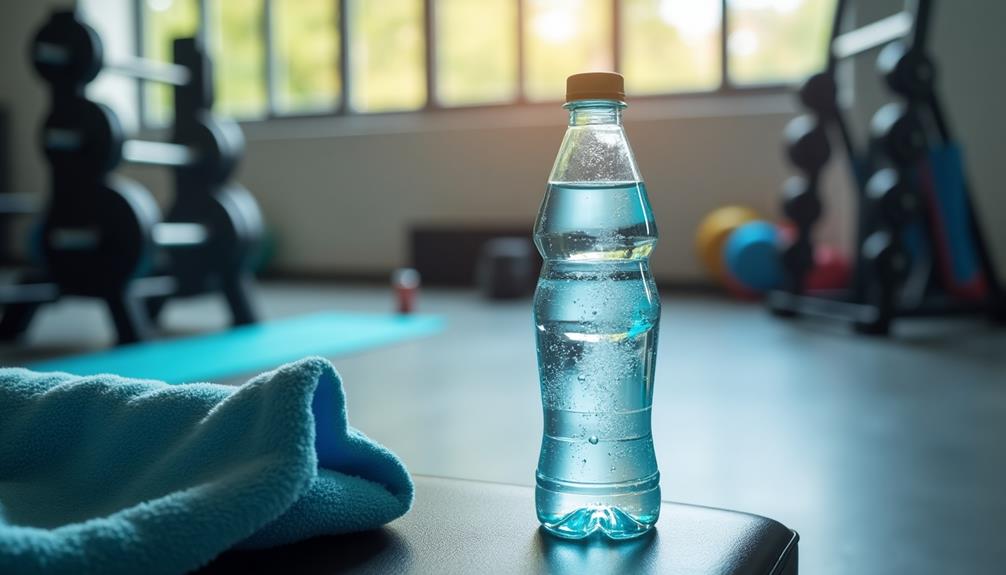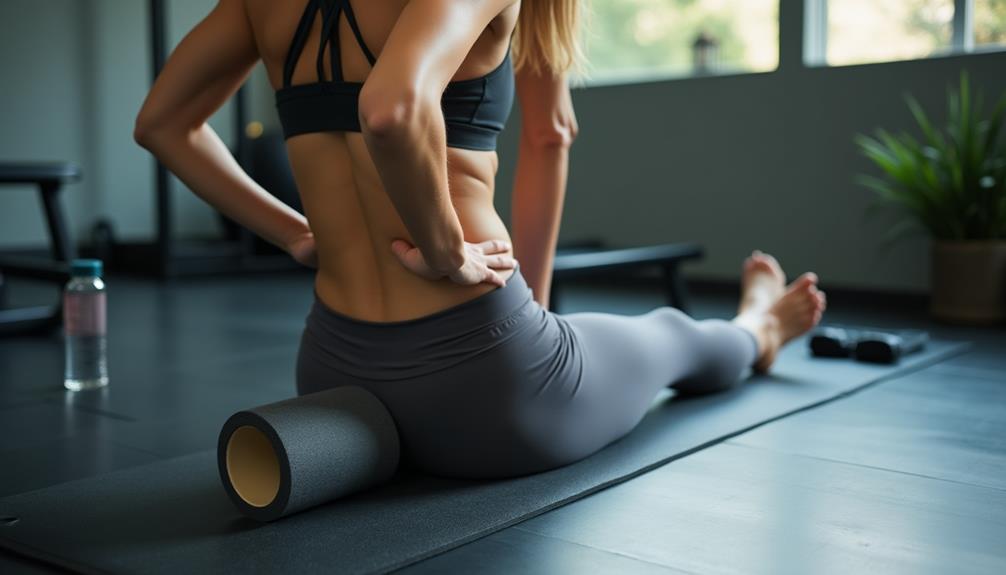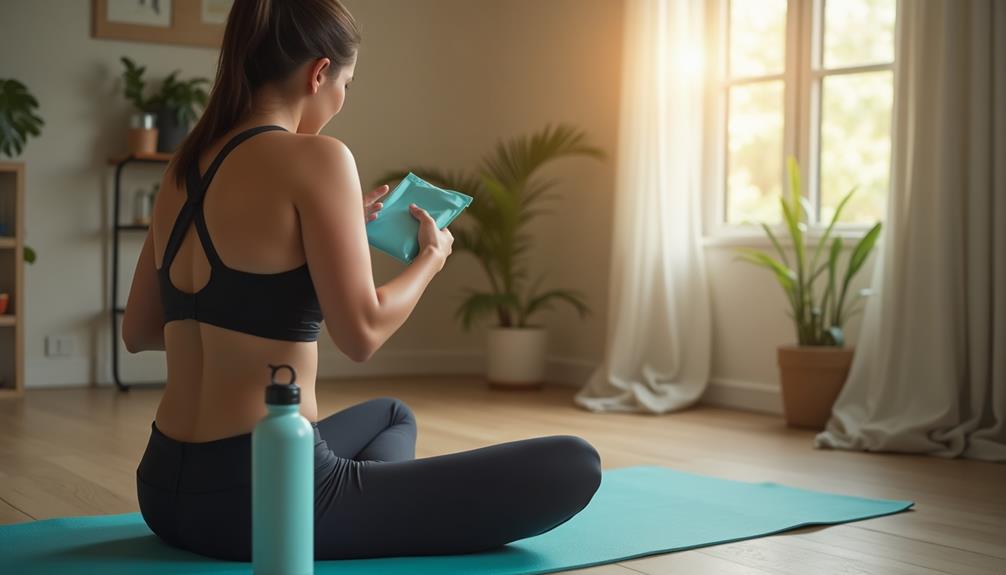To manage muscle soreness after lifting, start with hydration. Drink plenty of water before, during, and after workouts. Next, implement active recovery like walking or yoga to loosen tight muscles. Prioritize proper nutrition by eating a balanced meal rich in protein and carbs within 30 to 60 minutes post-workout. Foam rolling is another effective way to relieve soreness; target areas like your quads and back for about 30 seconds each. Finally, consider cold therapy using ice packs or baths to reduce inflammation. These strategies can greatly enhance your recovery—stick around to find out even more helpful tips!
Core Insights
- Stay hydrated by drinking water and electrolyte-rich beverages before, during, and after workouts to aid recovery and minimize soreness.
- Implement active recovery techniques, such as walking, stretching, and swimming, to loosen tight muscles and enhance circulation.
- Prioritize proper nutrition by consuming a balanced meal with protein and carbohydrates within 30 to 60 minutes post-workout for optimal recovery.
- Use foam rolling techniques on sore muscle areas to release tension and improve flexibility through targeted pressure.
- Consider cold therapy, such as ice packs or cold baths, to reduce inflammation and numb pain within 48 hours after your workout.
Stay Hydrated

Staying hydrated is essential for managing muscle soreness after lifting. When you lift weights, your body loses fluids through sweat. This can lead to dehydration, which may worsen soreness and delay recovery. Aim to drink water before, during, and after your workouts. Coconut water brands can also provide excellent hydration and electrolyte replenishment, with options like Zico and CoAqua offering natural electrolytes and minimal added sugars.
A good rule of thumb is to consume at least half your body weight in ounces of water daily. For instance, if you weigh 160 pounds, aim for 80 ounces. You can also include hydrating foods like fruits and vegetables in your diet.
Listen to your body; if you feel thirsty or fatigued, drink up. Remember, proper hydration helps transport nutrients to your muscles, aiding in recovery. So, keep that water bottle close and stay refreshed!
Implement Active Recovery

- Walking: A gentle stroll can help loosen tight muscles. Chlorella supplements can aid in muscle recovery and detoxification after exercise. Consider incorporating these natural supplements into your post-workout routine.
- Stretching: Focus on light static stretches to enhance flexibility.
- Yoga: Incorporating yoga can improve circulation and reduce tension.
- Swimming: The buoyancy of water eases stress on joints while providing a workout.
Prioritize Proper Nutrition

Your body's recovery hinges on the nutrition you provide after lifting weights. To minimize muscle soreness, focus on consuming a balanced meal rich in protein and carbohydrates. Protein helps repair and build muscle fibers, while carbohydrates replenish your energy stores. For a convenient option, consider post-workout protein bars that offer a balanced mix of protein and carbs to support recovery. These bars can be especially useful when you're on the go or don't have immediate access to a full meal.
Aim to eat within 30 to 60 minutes after working out. This timing maximizes nutrient absorption. A protein shake with a banana is an excellent option for quick recovery.
Don't forget hydration! Water plays an essential role in recovery, so drink plenty throughout the day.
Incorporate nutrient-rich foods into your diet, like leafy greens and nuts. They provide essential vitamins and minerals that support recovery.
Use Foam Rolling Techniques

- Choose the right foam roller: Opt for a roller that suits your needs, whether it's firm for deep tissue or softer for gentle relief.
- Target sore areas: Focus on muscles that feel tight after your workouts, like quads, hamstrings, and back.
- Roll slowly: Spend about 30 seconds on each muscle group, allowing the roller to work out knots and tension.
- Breathe deeply: Relax and breathe during the process to help release muscle tightness more effectively.
Implement these techniques, and feel the difference!
Consider Cold Therapy

Cold therapy can be a powerful tool for managing muscle soreness after lifting, as it helps reduce inflammation and numb sharp pain. You can easily incorporate this method into your recovery routine.
Consider using ice packs or cold compresses on sore areas for 15 to 20 minutes. Be sure to wrap the ice in a towel to protect your skin. Alternatively, an ice bath can provide full-body relief. If you're not keen on ice baths, try a contrast bath, alternating between cold and warm water.
Aim to apply cold therapy within the first 48 hours after your workout. This timing can maximize its effectiveness. Remember, consistency is key in your recovery efforts, so don't skip this important step!
Frequently Asked Questions
How Long Does Muscle Soreness Typically Last After Lifting?
Muscle soreness after lifting usually peaks within 24 to 48 hours. It can last anywhere from a few days to a week, depending on your workout intensity and your body's recovery ability.
Is Muscle Soreness a Sign of Effective Workouts?
Imagine your muscles working hard, fibers tearing and rebuilding. Yes, muscle soreness often signals effective workouts, indicating you've pushed your limits. It's a reminder that growth and strength are just around the corner. Embrace it!
Can I Exercise With Muscle Soreness?
Yes, you can exercise with muscle soreness. Just listen to your body and modify your routine. Light activities or low-impact workouts can help promote recovery without overstressing your muscles. Prioritize rest if soreness becomes severe.
When Should I Seek Medical Attention for Soreness?
Did you know that about 20% of individuals experience severe muscle soreness? If you notice persistent pain, swelling, or difficulty moving, it's time to seek medical attention. Don't ignore these signs; your health matters.
Does Stretching Help Reduce Muscle Soreness Post-Workout?
Stretching can help improve flexibility and blood flow, which might ease muscle soreness after a workout. However, it's not a guaranteed solution. Listen to your body and combine stretching with proper recovery techniques for best results.

